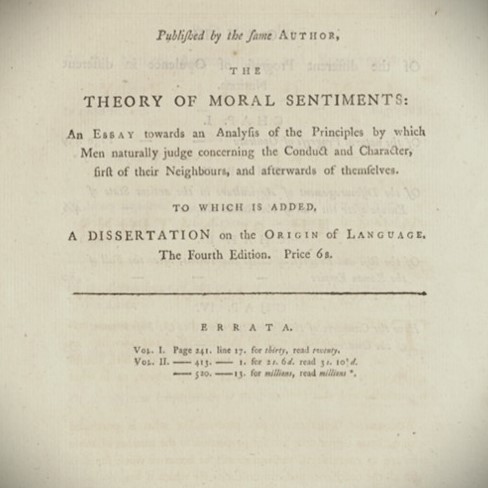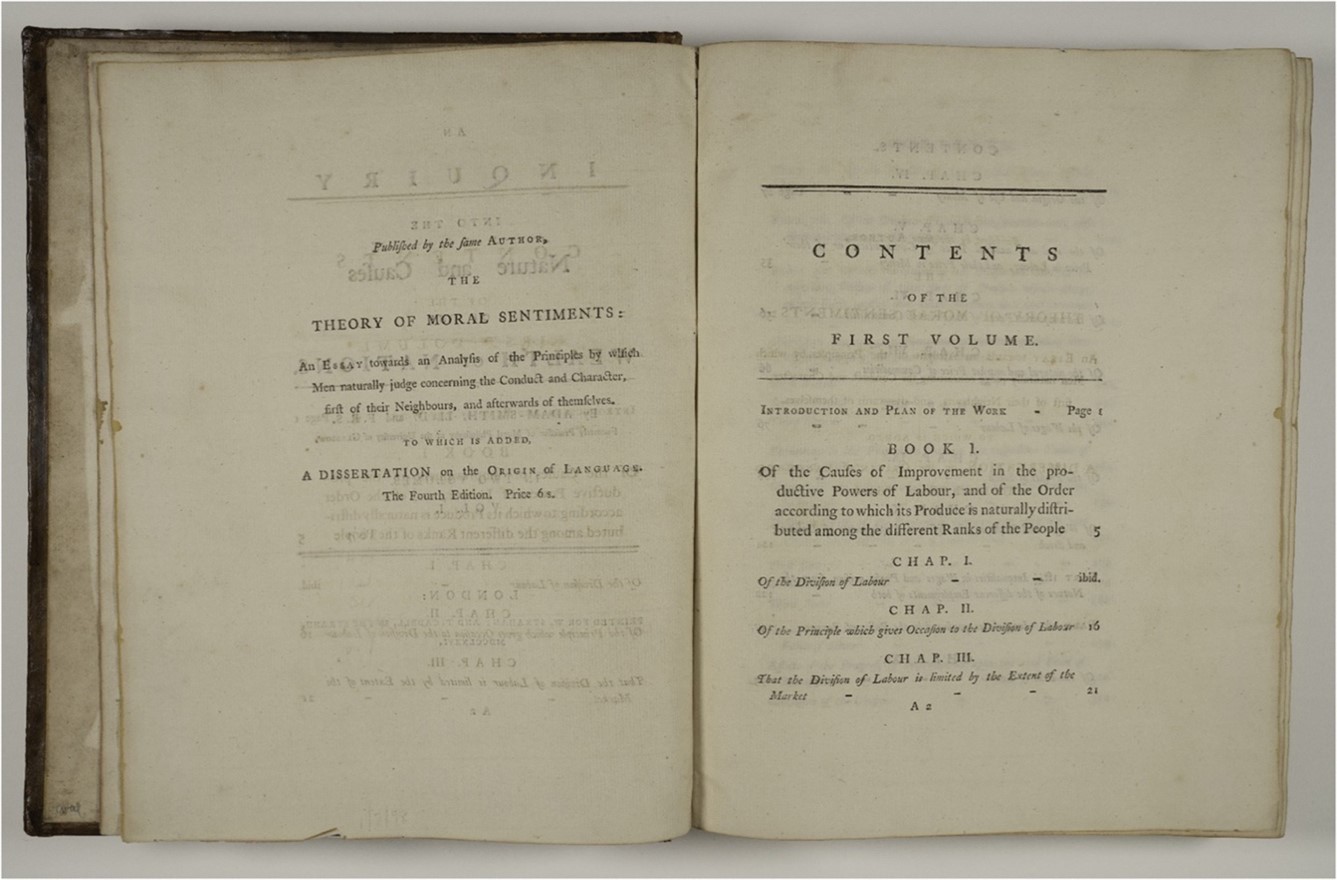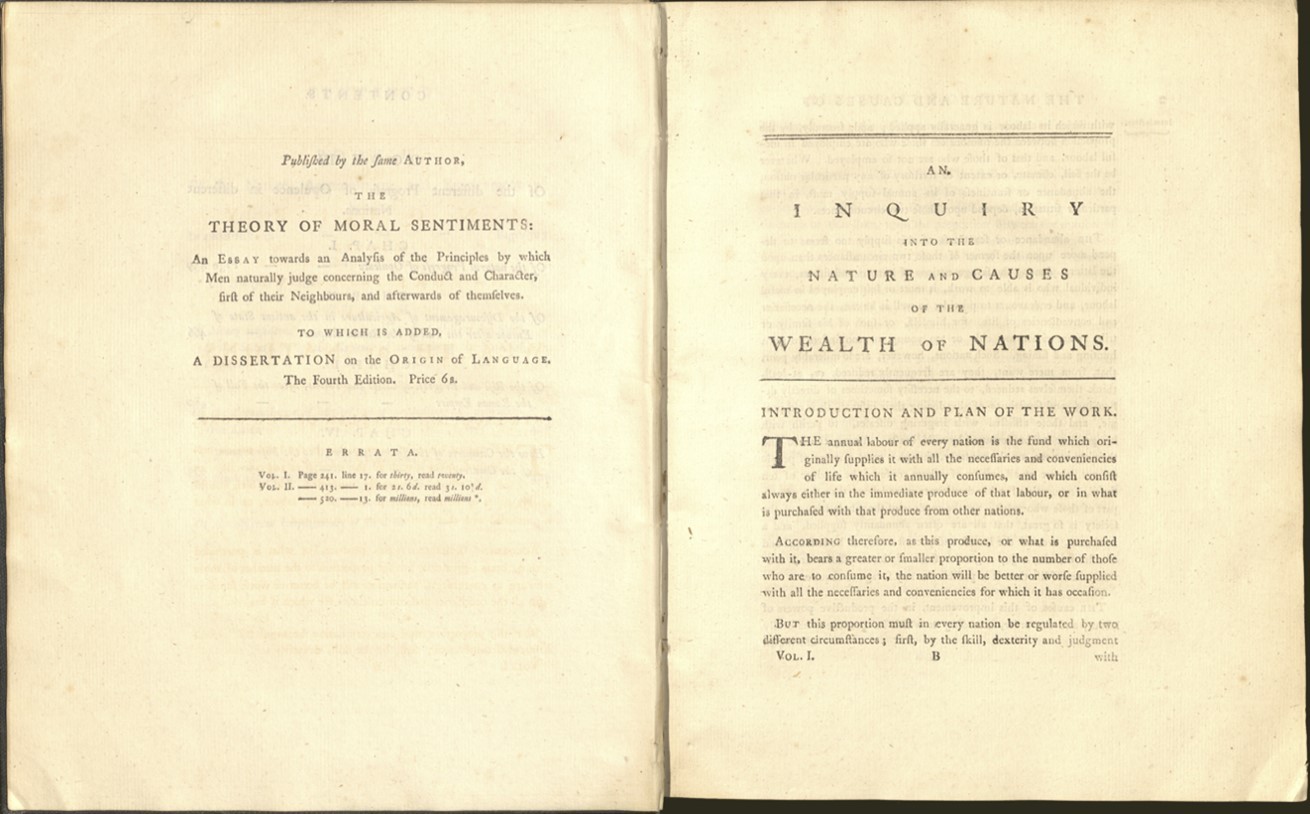Signaling Adam Smith's System through “By the Same Author”
January 25, 2023

Breashears shows that there's always more to learn from Adam Smith - not only from the content of his writing but from the paratexts of his work as well.
"Seeing Smith's paratextual materials, we recover some of the fullness of Smith’s outlook for human life in modern times."

Breashears shows that there's always more to learn from Adam Smith - not only from the content of his writing but from the paratexts of his work as well.
"Seeing Smith's paratextual materials, we recover some of the fullness of Smith’s outlook for human life in modern times."
Paratexts are materials on the borders of the text, such as the title page, epigraph, table of contents, and index. The kind of paratext that concerns us here is the “by the same author” list. We find something interesting about “by the same author” in the early editions of Adam Smith's Wealth of Nations. I show images from the first and second editions and address how they were intended to shape their interpretations of Smith’s works as a whole. This article is a riff on an article in Economic Affairs by Dan Klein and me.
Gérard Genette suggests that paratexts offer a “threshold” designed to ensure “a better reception for the text and a more pertinent reading of it” (1997, 2). While the list of works “by the same author” was a common paratext in Smith's time, the placement in early editions of Wealth of Nations was unusual and goes beyond advertising Smith's earlier publications. Specifically, in the editions published in 1776 and 1778, the author-works lists reinforce Smith's overarching system across The Theory of Moral Sentiments, the essay on languages, and Wealth of Nations.
“Published by the same Author”
“Published by the same Author”
As Genette observes, “the list of works 'By the same author' [was] generally placed at the beginning of the volume (facing the title page) or at the end” (1997, 99). In 1776, however, William Strahan and Thomas Cadell published the first edition of Wealth of Nations with the author-works list directly opposite the table of contents (Figure 1).


Figure 1: Wealth of Nations (1776)
Image courtesy of St. Lawrence University Library
This placement was uncommon, as shown by a methodical search in the database Eighteenth-Century Collections Online (ECCO) focused on books published between 1759 and 1790 by "Strahan or Cadell" and including the phrase “by the same author.” Our search returned 160 books, all of which included an author-works list or a variation on it. The author-works list appears most commonly at the end of the book (91 of 160), and often before or on the title page (23 of the 160). Only three books, including Smith's Wealth of Nations (1776), placed the author-works list directly opposite the table of contents. In these three instances, that list functions as an advertisement, but its placement also prepares readers to see connections between the author's previous works and the new text.
The placement of Smith's author-works list signals that Wealth of Nations continues a system. As Figure 1 shows, Strahan and Cadell give the full titles of both The Theory of Moral Sentiments and its appendix, A Dissertation on the Origin of Language. This list of works "Published by the same Author" establishes Smith's expertise and invites readers to see Wealth of Nations (WN) as ongoing elaboration of a unified body of thought. WN enlarges the Smithian outlook.
In The Enlightenment and the Book (2006), Richard Sher writes that for Scottish authors, the “union of text and paratext was crucial for their personal reputations as authors” (p. 194). Sher emphasizes the importance of "the coherence and authenticity of the public’s image of the author as an individual whose works were joined together to form a unified and immediately recognizable whole” (pp. 159-160). Ian Ross (2010, p. 286) also notes the placement, observing that Smith or his publisher wanted readers to remember he was the author of The Theory of Moral Sentiments. These goals—advertising Smith's previous book and suggesting connections between the preceding works and the current one—extended to the second edition of Wealth of Nations.
In the 1778 edition, the placement of the author-works list moves to after the table of contents and opposite the start of Smith’s “Introduction and Plan of the Work,” as shown in Figure 2.

Figure 2: Paratext from The Wealth of Nations (1778)
In the 1778 edition, the placement of the author-works list moves to after the table of contents and opposite the start of Smith’s “Introduction and Plan of the Work,” as shown in Figure 2.

Figure 2: Paratext from The Wealth of Nations (1778)
Image courtesy of Special Collections Research Center, William & Mary Libraries
The placement in 1778 is more common than that of 1776: our search identified 23 other examples. These publications are, however, restricted to relatively few authors. In all examples, the list of the author's previous publications establishes his expertise and an argumentative thread across books. The author-works list serves a similar purpose in Smith's Wealth of Nations (1778), highlighting his interest in the principles of judgment (TMS) and the springs of exchange (the Language essay) emphasized in the Introduction to WN.
Searching personal correspondence, we find no evidence that Smith or his publishers intended for readers to see these particular connections. Also, they did not sustain this unusual placement of "by the same author" in the other editions of WN published during Smith’s lifetime.1 Yet if Smith's goals were to draw readers to his latest book and emphasize its connection to TMS, then he and his publishers may have felt they had already succeeded in signaling the unity of Smith’s works.
Connecting Smith's writings
Connecting Smith's writings
Modern editions of Smith’s works have eliminated the “by the same author” list. That is unfortunate, because that paratext in the first two editions of WN suggests philosophical connections across three texts:
- The Language essay
- The full title of The Theory of Moral Sentiments (TMS)
- WN under the ethical umbrella of TMS.2
In reading Smith's writings, our understanding of a part informs our understanding of the whole, while our understanding of the whole informs that of each part. The early WN “by the same author” lists helped us see how the parts complement one another and form a profound whole.
Smith’s Language essay first appeared in 1761 in The Philological Miscellany. The full title is “Considerations concerning the first formation of Languages, and the different genius of original and compounded Languages,” which appeared on the title page and in the table of contents from the third edition of TMS (1767) and thereafter.
The Language essay has extensive connections to both TMS and WN. For instance, the appending of the Language essay to TMS helps to make explicit deeper-evolution ideas that had been only implicit in TMS. In the Language essay, Smith writes: “The general rule would establish itself insensibly, and by slow degrees” (211). Such development parallels the spontaneous generation of proprieties in TMS. Indeed, language norms live in discourse, and discourse is a form of conduct, so language norms are proprieties. In discoursing, one’s semantics and syntax can be praiseworthy or blameworthy, virtuous or vicious.
Seeing the title of the Language essay opposite the table of contents of WN (1776) also reinforces Smith's understanding of connections across disciplines. Language not only develops “insensibly.” It is also, Smith hints, fundamental to trade. In WN, he refuses to name explicitly the origin of our “propensity to truck, barter, and exchange,” but he does suggest that it “seems more probable, it be the necessary consequence of the faculties of reason and speech” (25.2).
Likewise, it is crucial to read Wealth of Nations in relation to The Theory of Moral Sentiments. TMS is about seeing beauty and deformity in human conduct, or judging human conduct. WN instructs us in properly judging the conduct of those who make government policy, those who pursue honest income, and those who pursue dishonest income through government-conferred privilege.
Smith prepared readers for the content of Wealth of Nations at the end of early editions of The Theory of Moral Sentiments, where he looks forward to expounding on “the general principles which ought to run through and be the foundation of the laws of nations” (341.37). In his final edition of TMS (1790), Smith returns to this promise in another piece of paratext, his Advertisement. In so doing, Smith reinforces his sense of his own oeuvre:
In the last paragraph of the first Edition of the present work, I said, that I should in another discourse endeavour to give an account of the general principles of law and government, and of the different revolutions which they had undergone in the different ages and periods of society; not only in what concerns justice, but in what concerns police, revenue, and arms, and whatever else is the object of law. In the Enquiry concerning the Nature and Causes of the Wealth of Nations, I have partly executed this promise; at least so far as concerns police, revenue, and arms. What remains, the theory of jurisprudence, which I have long projected, I have hitherto been hindered from executing, by the same occupations which had till now prevented me from revising the present work. (3)
The placement and the argument of this paratext reinforce our point about the significance of the paratextual materials in WN.
Don’t expect too much from civilization
The final words of the Language essay say that Latin's conciseness, versification, and sweetness made perfection of beauty much more acquirable “than it can be to those whose expression is constantly confined by the prolixness, constraint, and monotony of modern languages” (226). These final words strike a dour note. Since the essay is an appendix which concludes TMS, that work itself ends on that dour note. This final phrase – “confined by the prolixness, constraint, and monotony of modern languages” – brings to mind the final words of WN, that Great Britain should “endeavour to accommodate her future views and designs to the real mediocrity of her circumstances” (WN, 947.92). Thus, Smith does not conclude with a zeal for progress. There is no promise of an integral, poetic life. In the Language essay, Smith explains, “mankind have learned by degrees to split and divide almost every event into a great number of metaphysical parts, expressed by the different parts of speech, variously combined in the different members of every phrase and sentence” (1983, p. 217; emphasis added). Dividing and subdividing is a main theme in WN. It is a central point of the Language essay, and we may read it into the rest of TMS. With the Language essay appended to TMS, both of Smith’s two great works end on a dour note.
Smith tended to presuppose that his readers enjoy stable, functional government. He counsels us to reform policy, if only gradually, in the direction of “the liberal plan” (WN 664.3), for the alternatives are worse. The unity of Smith’s thought tends toward the prospect of peaceful enjoyment of our circumstances with a sober regard for neighbors. Even if one’s small life within the modern liberal commercial society feels monotonous, Smith’s conception of the common good in the modern world is not without its lustre. Seeing Smith's paratextual materials, we recover some of the fullness of Smith’s outlook for human life in modern times.
Caroline Breashears is a Professor of English at St. Lawrence University.
This essay is part of the AdamSmithWorks series Just Sentiments curated by Daniel B. Klein and Erik Matson. New essays will be published on the fourth Wednesday of the month. You can read more about the series in this Speaking of Smith post, "Just Sentiments- Welcome!". Klein and Matson lead the Adam Smith Program in the Department of Economics at George Mason University, in association with the Mercatus Center. In the program, they study big ideas in jurisprudence, politics, ethics, and economics as they were pursued during the original arc of liberalism, especially in the 18th century in Britain.
References
Berry, Christopher J. 1974. Adam Smith’s Considerations on Language. Journal of the History of Ideas 35(1): 130-138.
Genette, Gerard. 1997. Paratexts: Thresholds of Interpretation. Trans. Jane E. Lewin. Literature, Culture, Theory Ser. No. 20. Cambridge University Press.
Klein, Daniel B. and Caroline Breashears. 2022. By the Same Author: Presenting Adam Smith's Works as a Whole. Economic Affairs 42: 528-540. Link
Matson, Erik W. 2022. God, Commerce, and Adam Smith through the Editions of The Theory of Moral Sentiments. Journal of Markets & Morality. 24(2): 269-288. Link
Ross, Ian Simpson. 2010. The Life of Adam Smith. Second edition. Oxford: Oxford University Press.
Sher, Richard B. 2006. The Enlightenment and the Book: Scottish Authors and Their Publishers in Eighteenth-Century Britain, Ireland, and America. University of Chicago Press.
Smith, Adam. 1976 [1776]. An Inquiry into the Nature and Causes of the Wealth of Nations. Edited by R.H. Campbell and A.S. Skinner. Oxford: Oxford University Press. Indianapolis: Liberty Fund, 1981.
Smith, Adam. 1790. The Theory of Moral Sentiments, eds. D.D. Raphael and A.L. Macfie. Oxford: Oxford University Press, 1976.
Smith, Adam. 1977 (Corr.). The Correspondence of Adam Smith, eds. Ernest C. Mossner and Ian Simpson Ross. Oxford: Clarendon Press.
Smith, Adam. 1983 (LRBL). Lectures on Rhetoric and Belles Lettres, ed. J. C. Bryce. Oxford: Clarendon Press.
Notes
- Smith spent much of the years 1773 to 1777 in London, enabling in-person communication with his publishers and printers. We have zero correspondence to or from Strahan or Cadell from 1767 until after WN was published in 1776. We know nothing of Smith’s instructions for WN’s printing and paratext in 1776 and 1778.↩
- As Erik Matson (2022, 269-273) puts it, there are two major problems in the Glasgow edition of the TMS volume. Both concern elements shown in Figure 1. One is the severing of the Language essay. The other is the failure to provide the full title of TMS on the title-page of the TMS volume—only in passing do the editors D.D. Raphael and A.L. Macfie provide the full title, on page 40 of their introduction. Raphael and Macfie do not explain why they made these changes.↩